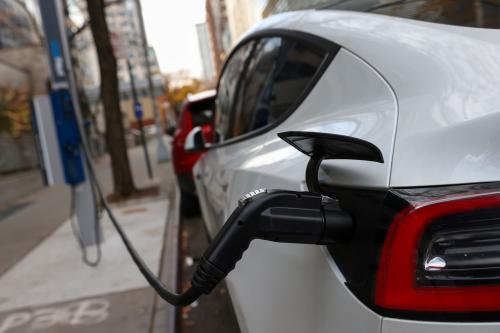The reemergence of concern about energy security in the wake of the September 2001 terror attacks amplified a theme that was already present in U.S. energy policy debates. World oil prices rose from about $10 a barrel in 1998 to more than $30 a barrel in late 2000, though they have since fallen below $20 a barrel. In 2000 the United States imported almost 60 percent of the petroleum it consumed; imports from the Organization of Petroleum Exporting Countries (OPEC) made up about a quarter of total U.S. consumption. Energy security was a central theme in the Bush administration’s energy policy report released by Vice President Cheney in the spring of 2001.
All kinds of policy goals have been advanced in the name of oil security. They range from drastic increases in motor vehicle fuel economy to more funding for wind energy to drilling in the Alaskan National Wildlife Refuge to jawboning Mexico to increase supplies and eschew cooperation with OPEC. Some of the proposals—in particular the notion of eliminating oil imports—have been plain silly. Almost all suffer from an apparent misunderstanding of the oil security problem—and the often contrasting policy implications of its different components. (Those of us who lived through similar debates in the late 1970s and early 1980s feel an alarming sense of déjà vu in all this; the half-life of common sense about energy policy apparently is fairly short.)
The Basics of Oil Security
The international oil security problem has two components. The first is the exercise of market power by international oil exporters to raise petroleum prices. For much of the 20th century the United States maintained a tariff on oil imports to protect its petroleum industry against lower-priced competition from abroad. By the early 1970s, concern had shifted to the ability of OPEC to restrict supplies and raise prices. While beneficial to U.S. oil producers, higher prices raise the real cost of domestic and imported oil for U.S. businesses and households, thereby crowding out other opportunities for consumption and saving.
The second component is macroeconomic disruptions arising from oil price instability. These disruptions became a concern during the 1970s, when oil price shocks were followed by economic downturns and inflation in the industrialized countries. Among the causes of oil price shocks are unexpected supply reductions by individual oil suppliers or suppliers as a group, unexpected surges in demand (caused, for example, by a cold winter), or destabilizing inventory adjustments (such as a build-up of stocks when the market already is tight). Oil price shocks appear to have consequences for the economy beyond the direct effects of an increase in energy costs.
Researchers have offered varied explanations for this multiplier effect. Energy price shocks could increase unemployment because worker productivity drops when energy use is curtailed in the face of rising prices and real wages do not fall along with productivity. A sharp and sustained increased in energy prices could idle fixed capital or make it prematurely obsolescent. The economy as a whole could experience adjustment costs as producers and consumers try to respond to the energy price hikes by altering the bundles of goods and services they make and buy. The direct and indirect burdens of higher energy prices are likely to be heaviest for lower-income groups.
The key issue in global oil security is not “running out”—the world has hundreds of years of existing and potential reserves. Nor is it targeted embargoes or how much oil the United States buys from particular countries—both are meaningless in an integrated world oil market. The key issue is energy prices.
OPEC and Oil Security
Beginning in the late 1990s, political and economic analysts pointed to what appeared to be a confident and resurgent OPEC ready to assume control of the world oil market. As causes, they cited a more cooperative leadership in Venezuela and (more recently) in non-OPEC Mexico, diminishing discord between Saudi Arabia and Iran, and the formal adoption of a target price band ($22-28 a barrel) that made OPEC’s oil production targeting seem more technocratic and less political.
Adam Smith would never see the current world oil market as a textbook example of perfect competition. In principle, OPEC should be able to exercise considerable market power given its large share of global production (around 40 percent, with a somewhat higher share of world production capacity). But reports of OPEC’s ascendancy may be premature. As noted, oil prices have fallen over the past year, and there is now talk of lowering the target price band. While the economic downturn and softening of world oil demand are partly responsible, OPEC’s difficulty in coping with these developments is telling. Moreover, just as the North Sea and a resurgent industry in North America during the 1970s stemmed OPEC’s ability to keep prices high, today Russia is raising its oil output. Other areas of the former Soviet Union around the Caspian Sea offer additional possibilities for expanded non-OPEC production in the future.
In the longer term, OPEC could be in a stronger position to exercise substantial market power. It controls around three-quarters of the world’s known oil reserves, and the U.S. Energy Information Administration projects that its share of world output could rise to 50 percent by 2020. Recent technical strides in oil recovery and discoveries of new oil reserves elsewhere are unlikely to reverse this state of affairs. And while the technological advances that have helped stabilize U.S. domestic output should continue to unfold, the United States will inevitably become more dependent on imports over the long haul. But the way to forestall stronger OPEC market dominance is not to be found in today’s renewed calls for “energy independence.”
The Costs of Market Volatility
Neither the demand for oil nor its supply is highly price sensitive in the short term. When supplies go down, prices have to rise considerably to adjust demand. No matter who produces the oil, a shock to global supplies (accidental or deliberate) will send oil prices up abruptly. While price shocks are uncomfortable, they are not likely to be severe or to last long. (There could be exceptions, such as losing Saudi Arabia’s entire output for five years.) Moreover, fairly large swings in petroleum prices seem to have become business as usual in an inherently volatile market. How serious, then, are the macroeconomic threats posed by oil price volatility?
A great deal of research finds that oil price jumps are linked empirically to slumps in macroeconomic performance, and that link is a legitimate concern for public policy. While individual oil buyers and sellers will have reason to hedge their own financial risks (buying more fuel-efficient equipment, holding inventories, hedging on the futures markets), they will not take into account the economy-wide stakes in the oil-intensity or broader energy-intensity of economic activity.
But many questions about the effects of oil shocks remain unanswered. How, exactly, do households and businesses respond to energy market disturbances? If an energy price shock is likely to be short-lived, why would it necessarily be so disruptive? Does the continued slow decline in the oil- and energy-intensity of the U.S. economy help explain why the link between energy prices and the economy seems to be getting somewhat weaker?
Notwithstanding the empirical uncertainty, three key points stand out. First, the vulnerability of the U.S. economy to oil price shocks depends on the intensity of petroleum consumption here and throughout the industrialized world, not on total U.S. imports or imports from the Middle East. Even if we could raise domestic output or reduce demand tomorrow to eliminate imports, a shock in world oil markets would still raise domestic prices and harm the economy because U.S. petroleum suppliers would charge the same price as other suppliers. The same is true if we could reduce our imports of more “insecure” oil and rely (as we already do) primarily on “safer” import sources: a shock anywhere in the world will be felt throughout an integrated world oil market.
Second, the economic cost of eliminating oil imports either by increasing domestic supplies or by reducing energy consumption would be enormous. The necessary domestic supply increases would be costly because the United States has depleted most of its low-cost reserves. The problem on the demand side is illustrated by a recent National Research Council report on how much vehicle fuel efficiency could be increased at a modest cost. Even the most optimistic perspectives in this report imply a huge cost to eliminate U.S. dependence on foreign oil.
Third, it is misleading to attribute the costly U.S. presence in the Middle East solely to the nation’s high degree of oil dependence and to argue that import reductions could significantly reduce the costs of Middle East involvement. As noted, materially reducing U.S. oil imports would be extremely costly—and the rest of the industrialized world would remain highly dependent on uncertain Middle East oil supplies. Moreover, the U.S. presence in the Middle East serves ends beyond oil security. Reducing U.S. oil imports would do little to lessen this presence.
Policy Implications
The Bush administration favors increasing domestic energy production to reduce dependence on foreign oil, along with some limited efforts to expand energy efficiency and alternative energy resources. Following the release of the administration’s plan, legislation was introduced in the House of Representatives to offer new tax breaks for domestic energy, including petroleum, and to open the Alaskan National Wildlife Refuge to oil exploration and production. Critics of the plan argue against ANWR drilling and for greater efforts to improve energy efficiency (in particular, vehicle efficiency), as well as to develop and expand the long-term use of domestic renewables.
Understanding the logic of the international oil security problem helps one sort through this welter of conflicting proposals. As noted, increasing U.S. domestic petroleum output will do relatively little to enhance energy security. A big increase in U.S. output could heighten competition for OPEC in the short to medium term, thereby moderating oil prices somewhat. But U.S. oil production is simply too high-cost (and reserves too limited) for increases in domestic output to affect OPEC much, especially over the long haul. Moreover, while increased U.S. output might fractionally reduce the probability and severity of disturbances in the world oil market, it will also increase vulnerability to the extent that it helps keep prices down and discourages longer-term reductions in the oil-intensity of overall economic activity. Again, the problem is total consumption relative to economic activity, not import dependence or sources of imports. Finally, the social cost of expanding domestic supplies by developing higher-cost resources and granting more indirect subsidies is likely to be considerable.
A corollary of this reasoning is that the energy security argument for drilling in ANWR is at best weak. Opening up ANWR can be debated on economic and environmental grounds (that is, the oil assets in ANWR have a social value if exploited, but so does preserving environmental conditions there). Output from ANWR could increase competition for OPEC in the medium term. But OPEC already faces and will continue to face competition from increases in other non-OPEC oil supplies, and the strength of OPEC’s market power remains open to debate. And increased ANWR output will fractionally reduce U.S. energy security by helping to maintain a more oil-dependent economic system.
The key to increasing U.S. energy security, from a macroeconomic perspective, is reducing the petroleum intensity of economic activity. Hot debate continues over how cost-effective conservation might be. The National Research Council study of vehicle fuel economy concluded that energy security benefits might be worth between 2 cents and 24 cents a gallon of gasoline, with a “best guess” of 12 cents. (My own view is more conservative.) Embedding these values in petroleum prices by, for example, a gasoline tax would only fractionally increase energy efficiency, though the increase would grow over time as vehicle purchases adjusted. And even if optimists are right about the low cost of regulated increases in fuel economy, these increases would come nowhere near eliminating exposure to macroeconomic adjustment costs.
While conservation and energy efficiency improvements can help enhance energy security, a more robust policy program would include other measures. In the shorter term, the government must figure out how to use the Strategic Petroleum Reserve more effectively. The Bush administration has restated the old and misguided view that the roughly 550-million-barrel reserve should be used only for some undefined “emergency,” not as a way of altering market prices. But if the energy security problem is fundamentally related to jumps in energy prices, should not moderating those prices be a central policy goal? In the past some analysts have called for treating the reserve as a publicly provided source of supplemental supply that the private sector can bid for through options contracts like those that already exist in commodity exchanges. That approach needs to be dusted off and seriously considered, together with a small excise tax on all petroleum consumption to pay for operating the reserve. Otherwise the reserve should be emptied and the funds from its sale devoted to more worthwhile purposes. Along with a better plan for managing the reserve, policymakers need to consider additional ways to reduce energy supply bottlenecks (like constraints on natural gas pipeline capacity) and to cost-effectively protect low-income groups from the full brunt of energy price jumps.
Over the longer term, affordable energy security will come mainly from increasing the diversity of energy sources and making energy consumption more responsive to price changes. One approach would be to expand the use of vehicles that use both gasoline and other fuels. Even better, for the long term, may be moving toward highly efficient and (eventually) nonfossil-based energy systems like hydrogen fuel cells. Unfortunately, most of the highly desirable new energy systems probably are still years (or even decades) away from large-scale commercial adoption. That may not be too long to wait if one views the energy security problem as manageable in the short term through the Strategic Petroleum Reserve and other measures, including unavoidable diplomatic and military efforts to protect oil supplies. Accelerating the pace of energy diversification would mean more public spending on a much more concerted effort to overcome technical hurdles. It would also require a change in the economic condition of energy markets—in which low fossil fuel prices make advanced technology development and diffusion unprofitable. We can get as much energy security as we are willing to pay for through a combination of higher current energy prices and increased R&D efforts. But we cannot get something for nothing, at the end of a drill bit or otherwise.



Commentary
International Oil Security: Problems and Policies
March 1, 2002